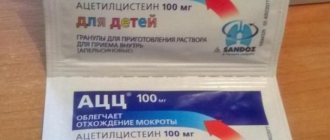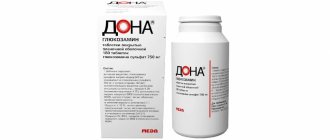pharmachologic effect
The product has a mucolytic effect. Due to the fact that the structure of the molecule contains acetylcysteine sulfhydryl groups, the disulfide bonds of acidic mucopolysaccharides of sputum are broken. As a result of this process, the viscosity of the mucus decreases. ACC 200 also demonstrates activity in patients with purulent sputum.
If acetylcysteine is used for prophylactic purposes, in patients who suffer from cystic fibrosis and chronic bronchitis , the severity and frequency of exacerbations decreases.
Terms of use
The rules for diluting the medicine are specified in the annotation. To create a liquid solution, the simplest algorithm is performed:
- The package is carefully opened along the cut line;
- pour into a cup;
- pour 3200 ml of hot water;
- stir.
The manufacturer points out that you cannot pour boiling water over the medicine - just use hot water.
To get the maximum effect from the medicine, you must consider:
- that the prepared solution is consumed immediately after eating and cannot be stored;
- a hot drink is absorbed faster into the gastrointestinal tract and accelerates the expected mucolytic effect;
- if the patient has a low-grade fever or fever, then cool the mixture before taking it;
- You should not use a drug prepared more than 3 hours ago - it is no longer suitable and will not be able to perform its intended functions.
You can also drink other warm liquids along with the medication. They will replenish losses, accelerate the liquefaction of sputum and speed up recovery.
The list of special dosage regimens includes:
- The need for long-term therapy is daily intake of 400 to 600 mg, divided into several procedures. The duration of the manipulations should not exceed 3-6 months, the final dates are set by the local therapist.
- Treatment of cystic fibrosis - 200 mg three times a day.
If excessive secretion and cough continue after two weeks of therapy, then a repeat diagnostic examination and revision of the initial diagnosis is necessary.
Indications for use
The use of ACC 200 is indicated in the following cases:
- for diseases of the respiratory system, if the formation of viscous sputum occurs, which is difficult to separate ( laryngotracheitis , acute / chronic / obstructive bronchitis, bronchiectasis, cystic fibrosis, pneumonia, bronchial asthma , bronchiolitis );
- otitis media;
- sinusitis acute and chronic.
Contraindications
It is contraindicated to take tablets in the following cases:
- high sensitivity to acetylcysteine or other drug ingredients;
- period of exacerbation of stomach and duodenal ulcers ;
- pulmonary hemorrhage;
- hemoptysis;
- pregnancy and feeding ;
- lactose intolerance, lactase deficiency;
- glucose-galactose malabsorption;
- child's age up to 2 years.
gastric ulcers or if there is histamine intolerance. The medicine is also carefully prescribed to people with bronchial asthma , esophageal varicose veins, obstructive bronchitis, adrenal gland diseases, liver and kidney , and arterial hypertension .
ACC powder
Release form
Powder for the preparation of solution for oral administration. White or yellowish in color, partially agglomerated, with an odor of orange or lemon and honey.
Compound
Active ingredient: acetylcysteine (100 or 200 mg for orange scent, 200 or 600 mg for lemon-honey scent).
Excipients:
- Lemon-honey - sucrose, ascorbic acid, sodium saccharinate, lemon flavor, honey flavor.
- Orange - sucrose, ascorbic acid, saccharin, orange flavor.
Pharmacological group
Secretolytics and stimulants of motor function of the respiratory tract.
Action
Mucolytic agent with expectorant action. Acetylcysteine increases the volume of sputum, facilitates its discharge due to a direct effect on the rheological properties of sputum, and has an anti-inflammatory effect by suppressing the formation of free radicals and reactive oxygen-containing substances responsible for the development of inflammation in the lung tissue.
Acetylcysteine: description of the substance
Indications
Respiratory diseases and conditions accompanied by the formation of viscous and mucopurulent sputum: acute and chronic bronchitis, obstructive bronchitis, tracheitis, laryngotracheitis, pneumonia, lung abscess, bronchiectasis, bronchial asthma, COPD, cystic fibrosis. Inflammation of the middle ear, acute and chronic sinusitis.
Contraindications and restrictions
- Peptic ulcer of the stomach and duodenum in the acute phase,
- hemoptysis, pulmonary hemorrhage,
- pregnancy and lactation (breastfeeding),
- children's age up to 2 years (for a dosage of 100 mg), up to 6 years (for a dosage of 200 mg), up to 14 years (for a dosage of 600 mg),
- sucrase/isomaltase deficiency, fructose intolerance, glucose-galactose deficiency,
- hypersensitivity to acetylcysteine and other components of the drug.
Carefully
- History of gastric and duodenal ulcers;
- bronchial asthma;
- obstructive bronchitis;
- liver and/or kidney failure;
- histamine intolerance (long-term use should be avoided);
- varicose veins of the esophagus;
- adrenal gland diseases;
- arterial hypertension.
Application and dosage
Inside after meals. Additional fluid intake enhances the mucolytic effect of the drug.
- Hot drink . Lemon and honey powder is dissolved in 1 glass (150-200 ml) of hot, but not boiling, water. Drink hot, but if necessary, the solution can be left for 3 hours.
- Cold drink . Orange powder is dissolved in 1 glass (150-200 ml) of water at room temperature.
Adults and teenagers over 14 years of age:
- ACC 600 mg. 1 sachet 1 time per day.
- ACC 200 mg. 1 sachet 2-3 times a day (400-600 mg per day).
- ACC 100 mg. 2 sachets 2-3 times a day (400-600 mg per day).
Children from 6 to 14 years old:
- ACC 200 mg. 1 sachet 2 times a day or 1/2 sachet 3 times a day (300-400 mg per day).
- ACC 100 mg. 1 sachet 3 times a day or 2 sachets 2 times a day (300-400 mg per day).
Children from 2 to 6 years old:
- ACC 100 mg. 1 sachet 2-3 times a day (200-300 mg per day).
- ACC 200 mg. 1/2 sachet 2-3 times a day (200-300 mg per day).
For short-term diseases, the course of treatment is 5-6 days. For long-term illnesses, the course of therapy is determined by the attending physician. For chronic bronchitis and cystic fibrosis, the drug should be taken for a longer period of time to achieve a preventive effect against infections.
For cystic fibrosis:
- Adults and children weighing ≥30 kg: if necessary, the daily dose can be increased to 800 mg per day.
- Children over 6 years: 600 mg per day.
special instructions
The drug contains sucrose, which must be taken into account when treating patients with diabetes.
When working with the drug, you must use glass containers and avoid contact with metals, rubber, oxygen, and easily oxidized substances.
Storage
In a place protected from light, at a temperature not exceeding 25 °C. Shelf life - 3 years (lemon-honey), 4 years (orange).
Production
- Sandoz d.d. (Slovenia)
- Salutas Pharma GmbH (Germany)
- Lindopharm GmbH (Germany)
Package
Powder 3 g in a bag of three-layer material, 6, 10, 20 or 50 bags in a cardboard box.
Recipe
Available without a prescription.
Side effects
The following side effects may occur while taking the drug:
- nervous system: tinnitus, headache ;
- cardiovascular system: decreased blood pressure , tachycardia ;
- digestion: diarrhea , nausea, vomiting, stomatitis ;
- allergic reactions: isolated manifestations - bronchospasm , urticaria , itching , skin rash;
- other reactions: isolated manifestations - bleeding.
Effervescent tablets ACC 200, instructions for use (Method and dosage)
The instructions for use of ACC 200 stipulate that the medicine, like the powder, is prescribed to patients over 14 years of age, 200 mg two to three times a day.
Patients from 6 to 14 years old take 1 tablet twice a day.
Children aged 2 to 5 years should take half a tablet of ACC 200 two to three times a day.
Patients with cystic fibrosis after 6 years are advised to take 1 tablet. 3 times a day, children under 6 years of age are prescribed the drug at the rate of 400 mg of acetylcysteine per day. If the patient's weight exceeds 30 kg, the dose, if necessary, is increased to 800 mg per day.
If colds are being treated, the course of treatment lasts 5-7 days.
Before taking the medicine and after, you need to drink plenty of fluids to enhance the mucolytic effect of the drug. You need to take the drug after meals.
The method of diluting the tablets is the same as the method of using the powder. They need to be dissolved in half a glass of water and the solution should be drunk immediately.
Buy ACC 200 powder for preparing a solution for oral administration Orange 3g No. 20 in pharmacies
ACC Buy ACC in pharmacies DOSAGE FORMS granules for the preparation of solution for oral administration orange 200 mg
MANUFACTURERS Salutas Pharma GmbH (Germany)
GROUP Mucolytic agents
COMPOSITION The active substance is acetylcysteine.
INTERNATIONAL NON-PROPENTED NAME Acetylcysteine
SYNONYMS Acetylcysteine, Acetylcysteine Sediko effervescent instant, Acetylcysteine Stada International, Acetylcysteine-Hemofarm, ACC 100, ACC 200, ACC injection, ACC Long, Vicks Active ExpectoMed, Muco Sanigen, Mukobene, Mukonex, Tussicom, Fluimucil
PHARMACOLOGICAL ACTION Mucolytic agent. Pharmacodynamics. The presence of sulfhydryl groups in the structure of acetylcysteine promotes the rupture of disulfide bonds of acidic mucopolysaccharides of sputum, which leads to a decrease in the viscosity of mucus. The drug remains active in the presence of purulent sputum. With the prophylactic use of acetylcysteine, there is a decrease in the frequency and severity of exacerbations in patients with chronic bronchitis and cystic fibrosis.
INDICATIONS FOR USE Diseases of the respiratory system, accompanied by the formation of viscous, difficult to separate sputum: acute and chronic bronchitis, obstructive bronchitis, laryngotracheitis, pneumonia, bronchiectasis, bronchial asthma, bronchiolitis, cystic fibrosis. Acute and chronic sinusitis, inflammation of the middle ear (otitis media).
CONTRAINDICATIONS Hypersensitivity to acetylcysteine or other components of the drug, pregnancy, breastfeeding, children under 2 years of age.
SIDE EFFECTS In rare cases, headaches, inflammation of the oral mucosa (stomatitis) and tinnitus are observed. Extremely rare - diarrhea, vomiting, heartburn and nausea, drop in blood pressure, increase in heart rate (tachycardia). In isolated cases, allergic reactions such as bronchospasm (mainly in patients with bronchial hyperreactivity), skin rash, itching and urticaria are observed. In addition, there are isolated reports of bleeding due to hypersensitivity reactions. If side effects develop, you should stop taking the drug and consult a doctor.
INTERACTION With the simultaneous use of acetylcysteine and antitussives, mucus stagnation may occur due to suppression of the cough reflex. Therefore, such combinations should be selected with caution. The simultaneous use of acetylcysteine and nitroglycerin can lead to an increase in the vasodilatory effect of the latter. Pharmaceutically incompatible with antibiotics (penicillins, cephalosporins, erythromycin, tetracycline and amphotericin B) and proteolytic enzymes. Upon contact with metals and rubber, sulfides with a characteristic odor are formed. Reduces the absorption of penicillins, cephalosporins, tetracycline (they should be taken no earlier than 2 hours after ingestion of acetylcysteine).
METHOD OF APPLICATION AND DOSAGE In the absence of other prescriptions, it is recommended to adhere to the following dosages: Mucolytic therapy. Adults and adolescents over 14 years of age are recommended to take 1 sachet 2 - 3 times a day (400 - 600 mg per day). Children aged 6 to 14 years are recommended to take ACC® 200 mg 3 times a day, 1 sachet or 2 times a day, 1 sachet (300 - 400 mg per day). Children aged 2 to 5 years are recommended to take 2-3 times a day, 1/2 sachet (200-300 mg per day). Cystic fibrosis. Children over 6 years of age are recommended to take 1 sachet (600 mg per day) 3 times a day. Children aged 2 to 5 years are recommended to take 1/2 sachet (400 mg per day) 4 times a day. For patients with cystic fibrosis and a body weight of more than 30 kg, if necessary, the dose can be increased to 800 mg of acetylcysteine per day. The granules should be dissolved in water, juice or iced tea and taken after meals.
OVERDOSE In case of erroneous or intentional overdose, phenomena such as diarrhea, vomiting, stomach pain, heartburn and nausea are observed. To date, no severe or life-threatening side effects have been observed.
SPECIAL INSTRUCTIONS With caution - peptic ulcer of the stomach and duodenum in the acute stage; hemoptysis, pulmonary hemorrhage, esophageal varices, bronchial asthma, adrenal diseases, liver and/or kidney failure. Pregnancy and breastfeeding For safety reasons, due to insufficient data, the use of the drug during pregnancy and breastfeeding is only possible if the expected benefit to the mother outweighs the potential risk to the fetus or infant. For patients with bronchial asthma and obstructive bronchitis, acetylcysteine should be prescribed with caution under systematic monitoring of bronchial patency. When treating patients with diabetes, it is necessary to take into account that the drug contains sucrose. When working with the drug, you must use glass containers and avoid contact with metals, rubber, oxygen, and easily oxidized substances.
STORAGE CONDITIONS Store in a dry place, protected from light, at a temperature not exceeding 25 C.
Interaction
It should be borne in mind that when taking ACC 200 and other cough suppressants simultaneously, dangerous mucus stagnation may develop due to the fact that the cough reflex is suppressed. Therefore, such drugs must be combined carefully.
Acetylcysteine may enhance the vasodilatory effect of Nitroglycerin if these drugs are taken simultaneously.
There is a synergism between acetylcysteine and bronchodilators.
Acetylcysteine is not compatible pharmaceutically with antibiotics (penicillins, cephalosporins, Amphotericin B , Erythromycin , Tetracycline ) and proteolytic enzymes .
When taken simultaneously, acetylcysteine reduces the absorption of tetracycline, cephalosporins, and penicillins. Therefore, you need to take such drugs at intervals of at least two hours.
If acetylcysteine comes into contact with rubber or metals, sulfides are formed, which have a characteristic odor.
Acc® long
Manufacturer: SANDOZ dd (Slovenia)
◊ tab. effervescent 600 mg: 6, 10 or 20 pcs. Reg. No.: P N008857
Clinical and pharmacological group:
Mucolytic drug
Release form, composition and packaging
◊ Effervescent tablets
white, round, chamfered, with a notch on one side, with a smooth surface, with the smell of blackberries; When 1 tablet is dissolved in 100 ml of water, a colorless transparent solution with a blackberry odor is obtained.
| 1 tab. | |
| acetylcysteine | 600 mg |
Excipients:
citric acid - 625 mg, sodium bicarbonate - 327 mg, sodium carbonate - 104 mg, mannitol - 72.8 mg, lactose - 70 mg, ascorbic acid - 75 mg, sodium cyclamate - 30.75 mg, sodium saccharinate dihydrate - 5 mg, sodium citrate dihydrate — 0.45 mg, blackberry flavor “B” — 40 mg.
6 pcs. — polypropylene tubes (1) — cardboard packs. 10 pieces. — polypropylene tubes (1) — cardboard packs. 20 pcs. — polypropylene tubes (1) — cardboard packs.
Description of the active components of the drug "Acc® Long"
pharmachologic effect
Mucolytic drug. The presence of sulfhydryl groups in the structure of the acetylcysteine molecule promotes the rupture of disulfide bonds of acidic mucopolysaccharides of sputum, which leads to a decrease in the viscosity of mucus. The drug remains active in the presence of purulent sputum.
With the prophylactic use of acetylcysteine, there is a decrease in the frequency and severity of exacerbations in patients with chronic bronchitis and cystic fibrosis.
Indications
- diseases of the respiratory system, accompanied by the formation of viscous, difficult to separate sputum: acute and chronic bronchitis, obstructive bronchitis, laryngotracheitis, pneumonia, bronchiectasis, bronchial asthma, bronchiolitis, cystic fibrosis;
— acute and chronic sinusitis;
- otitis media.
Dosage regimen
Adults and teenagers over 14 years old
It is recommended to prescribe the drug at a dose of 600 mg (1 effervescent tablet), which corresponds to 600 mg of acetylcysteine per day.
For short-term colds
Duration of treatment is 5-7 days.
For long-term illnesses,
the duration of therapy is determined by the attending physician.
In case of chronic bronchitis,
the drug should be taken for a longer period of time to prevent infections.
The drug should be taken after meals.
Additional fluid intake enhances the mucolytic effect of the drug.
ACC® Long effervescent tablets should be dissolved in 1 glass of water. Take immediately after dissolution; in exceptional cases, you can leave the prepared solution for 2 hours.
Side effect
From the nervous system:
rarely - headache, tinnitus.
From the digestive system:
rarely - stomatitis; very rarely - diarrhea, vomiting, heartburn and nausea.
From the cardiovascular system:
very rarely - decreased blood pressure, tachycardia.
Allergic reactions:
in isolated cases - bronchospasm (mainly in patients with bronchial hyperreactivity), skin rash, itching and urticaria.
Other:
in isolated cases - the development of bleeding as a manifestation of a hypersensitivity reaction.
Contraindications
- pregnancy;
- lactation period (breastfeeding);
- children under 14 years of age;
- hypersensitivity to the components of the drug.
with caution in patients with
peptic ulcer of the stomach and duodenum in the acute phase, with hemoptysis, pulmonary hemorrhage, varicose veins of the esophagus, bronchial asthma, diseases of the adrenal glands, liver and/or kidney failure.
Pregnancy and lactation
Due to insufficient data, the use of the drug during pregnancy and lactation is possible only in cases where the expected benefit to the mother outweighs the potential risk to the fetus or child.
Use for liver dysfunction
The drug should be used with caution
used for liver failure.
Use for renal impairment
The drug should be used with caution
used for renal failure.
Application for children
Contraindications: children under 6 years of age (the drug is in the form of granules for the preparation of a solution for oral administration 200 mg); children under 14 years of age (dosage forms containing acetylcysteine 600 mg).
special instructions
For bronchial asthma and obstructive bronchitis, acetylcysteine should be prescribed with caution under systematic monitoring of bronchial patency.
If adverse reactions develop, the patient should stop taking the drug and consult a doctor.
When dissolving the drug, it is necessary to use glass containers and avoid contact with metals, rubber, oxygen, and easily oxidized substances.
When treating patients with diabetes, it is necessary to take into account that 1 effervescent tablet ACC Long® corresponds to 0.01 XE.
Overdose
Symptoms:
Possible diarrhea, vomiting, stomach pain, heartburn, nausea. To date, no severe or life-threatening adverse reactions have been observed.
Treatment:
carrying out symptomatic therapy.
Drug interactions
With the simultaneous use of acetylcysteine and antitussives, dangerous mucus stagnation may occur due to suppression of the cough reflex (use the combination with caution).
When taking acetylcysteine and nitroglycerin simultaneously, the vasodilatory effect of nitroglycerin may be enhanced.
Acetylcysteine reduces the absorption of cephalosporins, penicillins and tetracycline, so they should be taken orally no earlier than 2 hours after taking acetylcysteine.
Acetylcysteine is pharmaceutically incompatible with antibiotics (penicillins, cephalosporins, erythromycin, tetracycline and amphotericin B) and proteolytic enzymes.
When acetylcysteine comes into contact with metals and rubber, sulfides with a characteristic odor are formed.
Conditions for dispensing from pharmacies
The drug is approved for use as a means of OTC.
Storage conditions and periods
The drug should be stored out of the reach of children, in a dry place, protected from light, at a temperature not exceeding 30°C. Shelf life: 3 years.
After taking the tablet, the tube should be tightly closed.
Drug interactions
With the simultaneous use of acetylcysteine and antitussives, dangerous mucus stagnation may occur due to suppression of the cough reflex (use the combination with caution).
When taking acetylcysteine and nitroglycerin simultaneously, the vasodilatory effect of nitroglycerin may be enhanced.
Acetylcysteine reduces the absorption of cephalosporins, penicillins and tetracycline, so they should be taken orally no earlier than 2 hours after taking acetylcysteine.
Acetylcysteine is pharmaceutically incompatible with antibiotics (penicillins, cephalosporins, erythromycin, tetracycline and amphotericin B) and proteolytic enzymes.
When acetylcysteine comes into contact with metals and rubber, sulfides with a characteristic odor are formed.
special instructions
If ACC 200 is prescribed to patients with bronchial asthma and obstructive bronchitis, it is necessary to do this carefully and constantly monitor bronchial patency.
If any side effects develop, you should stop treatment and consult a doctor.
If necessary, dissolve the drug using glass containers.
Doctors do not recommend taking the drug before bed. It is advisable to do this before 18:00.
Patients with diabetes should note that ACC 200 contains sucrose.
The drug does not affect the ability to concentrate or drive vehicles.
General information
The medicine is an expectorant-type mucolytic, which allows you to accelerate the accumulation of sputum in the respiratory section. The product consists of small granular particles, each sachet contains 200 mg of active ingredients. The composition of the medication is represented by the following components:
- acetylcysteine;
- ascorbic acid;
- sucrose, saccharin;
- honey and citrus flavoring.
Granules are white, less often yellowish, with a pronounced aroma of honey and citrus.
An increase in the fluidity of thick mucous secretion, which arises under the influence of pathogenic microflora, occurs due to the active component acetylcysteine. Its effectiveness has been proven in clinical studies; good results are obtained even in the presence of purulent clots in the sputum.
Analogs
Level 4 ATX code matches:
Mukolik
Abrol
Ambrosan
Bronchorus
ACC 100
ACC Long
ACC
Mukolwan
Lazolvan
Bromhexine 8
Bromhexine 8 Berlin-Chemie
Bromhexine
Bronchobos
Carbocisteine
Erdomed
Pulmozyme
Pectolvan C
Halixol
Ambrobene
Acetylcysteine
Drugs that are analogues of ACC 200 are drugs ACC Long , Fluimucil , Acetylcysteine , N-acetylcysteine , Mucomist , Acestin , Mukonex , etc. Which of these drugs is the most optimal is determined by the doctor individually.
Price ACC 200, where to buy
The price of ACC 200 is on average 300 rubles for 20 pieces.
- Online pharmacies in RussiaRussia
- Online pharmacies in UkraineUkraine
ZdravCity
- ACC 200 tab.
thorn. 0.2g 20pcs Hermes Pharma Ges. M.b.H./Salutas Pharma GmbH RUB 131 order
Pharmacy Dialogue
- ACC 200 (spike tab. 200 mg No. 20) Hermes
117 RUR order
- ACC 200 (spike tab. 200 mg No. 20) Salutas Pharma GmbH
RUB 219 order
- ACC 200 (spike tab. 200 mg No. 20) Hermes
RUB 131 order
- ACC 200 (pack of granules 200 mg No. 20 (orange)) Salutas Pharma GmbH
109 rub. order
show more
Pharmacy24
- ACC 200 No. 20 tablets Salutas Pharma GmbH., Nimechchina/Hermes Pharma Ges.m.b.H., Austria
128 UAH order - ACC 200 mg No. 20 powder for oral use Salutas Pharma GmbH, Nimechchina / Lindopharm GmbH, / Zambon Switzerland Ltd, Switzerland
152 UAH order




